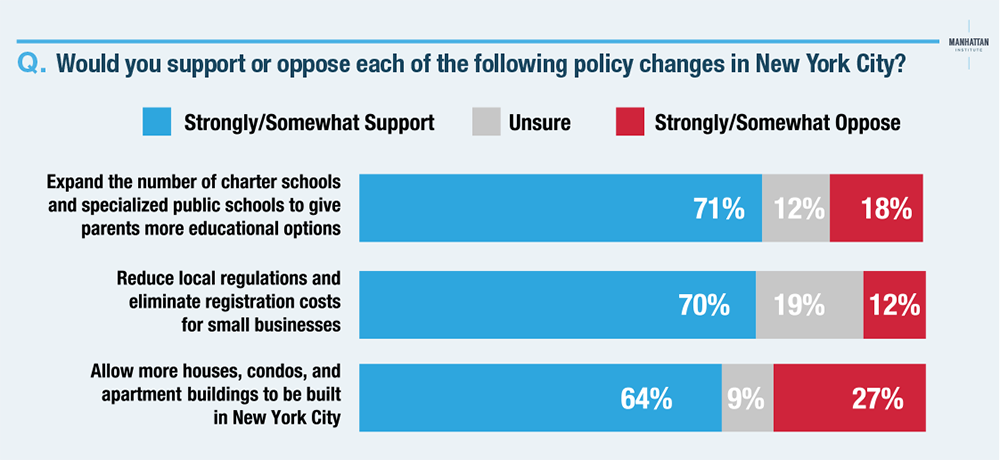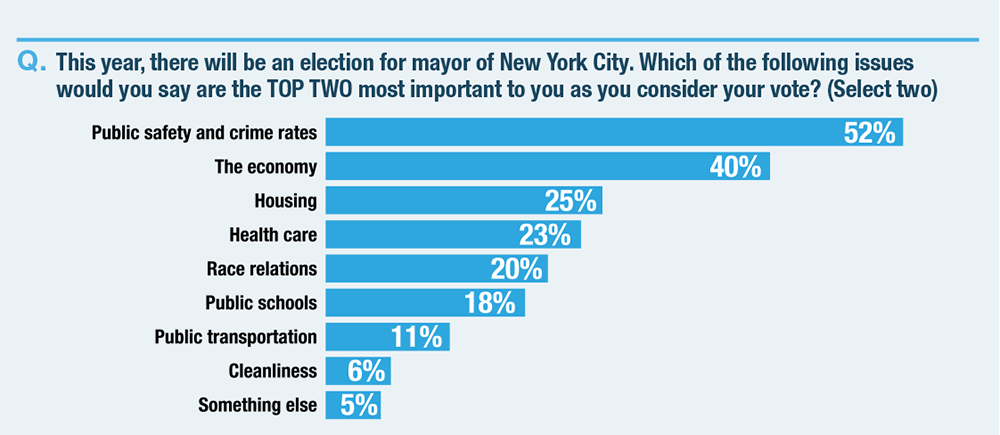What New Yorkers Want from a New Mayor

A large majority of registered voters in New York City support policy changes outlined in the Manhattan Institute’s Policy Playbook for New York’s Next Mayor,[1] according to a new poll of registered voters conducted by Echelon Insights for the Manhattan Institute.*
Recruiting more police officers with college degrees received the highest support, with 76% in favor and nearly half strongly in favor. This proposal found support among majorities across racial and ethnic groups, especially among Hispanic voters (86%). Empowering police officers to be more responsive to quality-of-life issues also received support from more than seven in 10 registered voters, including majorities of Republicans and Democrats.
Expanding charter and specialized public schools was supported by 71% of registered voters and 80% of parents. Cutting regulations and eliminating registration costs for small businesses was equally popular; only 12% opposed such a program. Allowing more apartment buildings, houses, and condos to be built in New York City garnered 64% support. Democrats are more enthusiastic in their support for more housing than Republicans, but majorities in both parties are in favor.
The only policy question asked in this survey that received divided support was on defunding the New York Police Department (NYPD) and spending the money on social workers instead, with 46% in support and 44% opposed, including 30% who were strongly opposed. But nearly half of respondents said that they’d prefer a larger police presence in their neighborhood than currently exists, and another 30% said that they want no change. Across all racial and ethnic groups, a majority supported either a larger or similar police presence. Only 15% of registered voters in New York City actually want fewer cops in their own neighborhood.
When asked what their top two priorities for the next mayor are, more than half of registered voters selected “public safety and crime rates,” which was at the top of the list. The economy was the second most selected, with 40% of voters including it in their top two. Housing, health care, and race relations were top priorities by at least two in 10 voters, followed by public schools (18%) and public transportation (11%).
These priorities vary: by location—residents of Brooklyn and the Bronx are more likely to rate the affordability of housing as poor and prioritize that issue; by age—younger New Yorkers are more pessimistic about the quality of public schools; and by gender—women are more likely to rank public safety and crime as poor. Meanwhile, housing is a bigger priority among Democrats, while public safety is more salient for Republicans.
New Yorkers appear reasonably upbeat about the future of the city. Slightly more than half of respondents (52%) believe that New York City is generally headed in the right direction. Yet the city’s outlook can vary considerably by partisan alignment. Democrats are much more likely to believe that the city is on the right track than Republicans, with the gap especially pronounced between those who identify strongly with either party.
On the specifics, New Yorkers appear somewhat less positive. Asked about the city’s public safety and crime rates, 51% of registered voters say that it is poor, compared with just 19% with a positive impression. Even starker is the divide on the affordability of housing, with only 16% saying it is good, while 60% believe it is poor. Democrats and progressives appear to agree on safety and housing as top challenges for the city’s next mayor. Economic conditions and the quality of public schools also get the thumbs down from all voters, though by somewhat smaller margins.
Our poll surveyed a voter base that skews Democrat (61%), including many strong Democrats (46% percent in all). Still, only 18% percent consider themselves “very liberal,” and nearly a third identified as moderates.
With New York City in the midst of one of the more consequential chapters in its history, these results should lead observers to question their assumptions of what New York voters want on specific policy matters. There appears to be a broad diversity of thought among the city’s electorate—to which its elected officials should pay attention.
Methodology
The survey of 1,000 registered voters in New York City was conducted during May 3–13, 2021, using a mixed-mode approach, with 485 respondents completing the survey online and the remainder being interviewed over the phone (CATI)—237 on landlines and 278 on cell phones. The web sample was from a general population web panel provided by Dynata, and the phone sample was drawn from a voter file. The sample was weighted to known characteristics of the registered voter population in New York City derived from U.S. Census Bureau estimates and the voter file, including gender, age, race and ethnicity, education, and borough, as well as the 2017 New York City mayoral election vote.
Endnote
1 Manhattan Institute, “A Policy Playbook for New York’s Next Mayor: Growth, Opportunity, and Safety.”
*For the entire survey results, see https://media4.manhattan-institute.org/sites/default/files/Manhattan-Institute-NYC-Survey-2021.pdf
About the Author
Michael Hendrix is director of state and local policy at the Manhattan Institute. Previously, he served as senior director for research and emerging issues at the U.S. Chamber of Commerce Foundation. Hendrix is a frequent public speaker, and his writings have appeared in, among others, National Review, City Journal, and National Affairs. He holds an M.A. in international relations from the University of St. Andrews (Scotland), as well as a certificate in strategy and performance management from Georgetown University.
Are you interested in supporting the Manhattan Institute’s public-interest research and journalism? As a 501(c)(3) nonprofit, donations in support of MI and its scholars’ work are fully tax-deductible as provided by law (EIN #13-2912529).


